- Details
- Hits: 1696
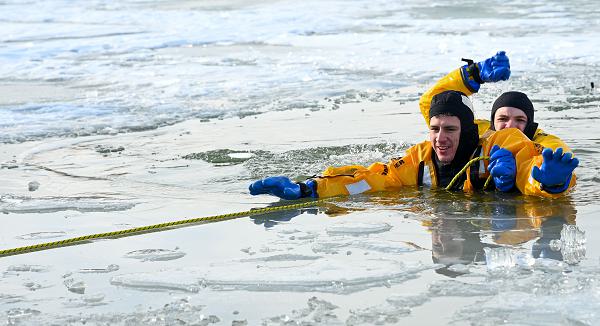
F.E. Warren Air Force Base, Wyoming. (January 26, 2024): In this photo by Airman 1st Class Mattison Cole, Airman 1st Class Victor Glavan and Airman David Dicken of the 90th Civil Engineer Squadron participate in an Ice Rescue Course for military and civilian life savers. The two-day course teaches everything from self-rescue to the medical effects cold temperatures have on victims.
The course begins with classroom instruction on how to retrieve a victim who is submerged in an icy lake without becoming a victim yourself. The first danger facing rescuers is the uncertainty of the thickness and stability of the ice. Students are taught the types of ice formations that may show signs of weakness and to always assume it won’t support you and your equipment. Students also learn how to diagnose and treat hypothermia and other freezing weather injuries.
During the second half of the training, students don exposure suits and practice rescue methods using their equipment in nearby Pearson Lake. The exposure suits not only keep the rescuer warm but also provide plenty of buoyancy depending on the type of suit they wear. As long as rescuers keep their neck above the surface of the water, they also will be kept dry.
Next comes the physical aspect of ice rescues which are summarized in the acronym Reach, Throw, Row, and Go.
- Details
- Hits: 1000
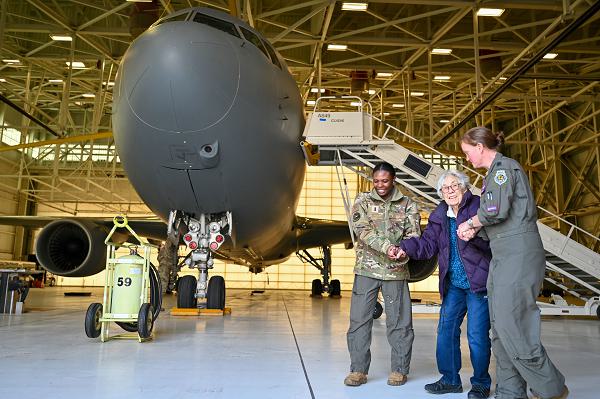
McConnell Air Force Base, Kansas. (February 11, 2024): In this photo by Airman 1st Class Gavin Hameed, First Lieutenant Micala Bruce, a 349th Air Refueling Squadron pilot, and Lieutenant Colonel Kristen Smith, the 349th ARS director of operations, give WWII veteran Katie Conkling a tour of the base to celebrate her 103rd birthday.
This remarkable person is a living witness to world events, including the Pearl Harbor attacks, that have shaped our society today. Conkling served as an Army Air Corps Staff Sergeant in the South Pacific during the war and the Air Force wanted to acknowledge her service and her incredible personal milestone.
Born Katherine V. “Katie” (Lawrence) Conkling in Coffeyville, Kansas on Jan. 18, 1921, she was the daughter of a first-generation German American carpenter from Wisconsin and a Texas landowner’s daughter. Her father died when she was a baby and her mother couldn’t care for her and her three brothers so they were placed in a Wichita Children’s Home. After graduating high school in 1939, Katie held a variety of posts until the Japanese attack on Pear Harbor spurred her to join the armed forces.
- Details
- Hits: 1035
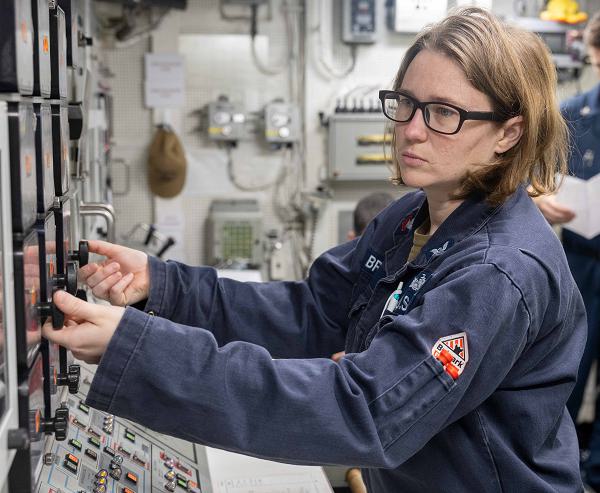
Philippine Sea. (January 29, 2024): Back when folks worked on their own cars, the “shade tree” mechanics would often boast about the size of the engines they have tackled. Nothing compares, however, to the size and complexity of the mighty turbines that power today’s Navy. In this photo by MC1 Ryre Arciaga, Gas Turbine Systems Technician (Electrical) 2nd Class Alyssa Bruce, from Powhatan, Virginia, regulates generator voltage using the electrical plant control console aboard the Arleigh Burke-class guided-missile destroyer USS Dewey. Gas Turbine Systems Technician – Electrical oversees the operation and maintenance of enormous gas turbine engines and other propulsion systems on a ship.
These highly trained technicians must know everything from operating electrical plants to repairing wiring and circuitry, all under the demanding pressure of a warship at sea. They operate the ships electric plant and perform many of the duties one expects from the local power company. They test circuits, batteries, connectors, and circuitry and repair and maintain all digital data equipment associated with the engines.
- Details
- Hits: 1186
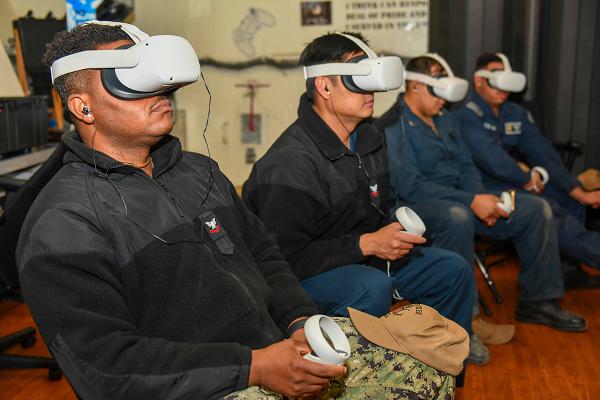
Naval Base San Diego, California. (January 29, 2024): Suicide among America’s military servicemembers is a recurring tragedy our nation has battled for years. Now, the armed forces have added a new tool, virtual reality, to the fight. In this photo by Seaman Tyler Miles, Sailors assigned to the amphibious assault ship USS Boxer are participating in a suicide prevention training pilot program using the latest virtual reality (VR) technology. This experimental effort, conducted at the Afloat Training Group, will use VR to train servicemembers on how to manage difficult mental health conversations. This new tool couldn’t come at a better time.’
Last year, the Army had the highest increase in suicides followed by the Marines with the Air Force experiencing only a slight uptick. The sad fact is many of these tragedies might be avoided if a fellow servicemember intervenes. The military is determined to equip servicemembers with the conversational tools they can use if they find themselves involved in these extremely challenging encounters.
Currently, the service branches teach suicide prevention in lecture-style courses that often lack practical application; “What can I do or say in these situations?” The VR experience allows students, overseen by coaches, to interact directly with fellow servicemembers in crisis under a variety of virtual scenarios. Participants are equipped with VR headgear in a one-on-one intervention with someone who is struggling with thoughts of suicide and are given prompts to help guide the discussion. Questions may range from “Are you thinking about hurting yourself” to “Do you have a gun in the house” and every encounter looks and feels like the real thing.
- Details
- Hits: 1961
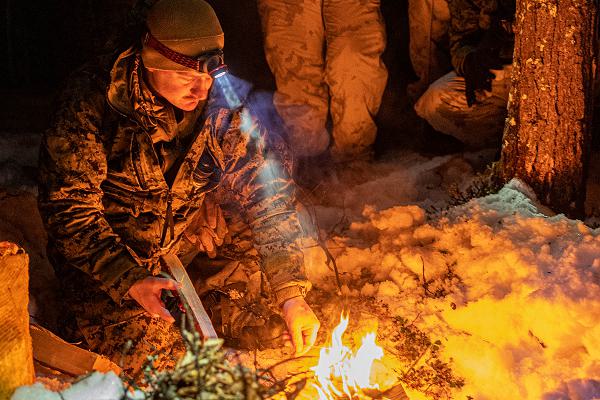
Setermoen, Norway. (January 28, 2024): NATO is welcoming its newest members in a big way by launching Nordic Response 2024, the alliance’s largest military exercise since the end of the Cold War. In this photo by Lance Cpl. Joshua Kumakaw, Sgt. Zachary Harper teaches fellow Marines how to build a fire in the freezing Arctic environment.
With Finland now a member and Sweden certain to join soon, NATO has expanded its annual Cold Response exercises to include Steadfast Defender in Germany, Poland and the Baltic states and another British-led marine exercise – Joint Warrior - which is being conducted in the sea areas between Scotland, Norway, and Iceland.
This year, over 20,000 servicemembers from fourteen countries will participate with Norway contributing around 8,000 troops, Norway adding 4,100 and 4,500 more from Finland. Other participating nations include the USA, Canada, Great Britain, Denmark, Germany, the Netherlands, Belgium, France, Spain, and Italy. The maneuvers will involve over fifty naval vessels, 110 aircraft , and more than fifty frigates and submarines. On the ground, some 11,000 troops will war game using tanks, artillery systems, and other tracked vehicles.
- Details
- Hits: 1339

Camp Hansen, Okinawa, Japan. (February 10, 2024): What is one of the most powerful weapons on the battlefield but doesn’t fire a thing? Camouflage. In the photo above, Lance Cpl. Alexander Moralesgarcia conducts a patrol during the 3rd Marine Division’s annual Squad Competition. This Marine is concealing his presence using a variety of camouflage methods that have been evolving since World War I.
In the early annals of warfare, individual troops did not spend much time on personal concealment as most battles were fought in large columns or in the trenches. It wasn’t until World War I and the invention of the airplane that military units began to concern themselves with shielding their location from above.
The first crude attempts at employing camouflage to confuse the enemy began with the Navy and the “razzle dazzle” design. These zebra-like patterns were emblazoned on American ships, not to conceal but rather to confuse enemy gunners. The design’s optical effect made it impossible for enemy gunners to get an accurate “fix” on a target’s range, speed, and heading which undoubtedly saved thousands of allied lives.
The use of camouflage by individuals on themselves and their equipment really expanded in the jungles and deserts during World War II. The goal of individual concealment centers on applying colors and distinctive shapes to break up the pattern of the human form or the straight lines of equipment and weapons.
The face-paint worn by the Marine above looks randomly applied but it actually follows a carefully researched process designed to deceive the human eye. This is done through “countershading” or preventing the casting of a shadow. The military also uses “mimicry” to make military vehicles appear to look like something they are not. This tactic was famously used against the Germans when the allies created “dummy” divisions that were supposedly to be led by General George Patton. The deception worked and undoubtedly saves thousands of lives on D-Day.


